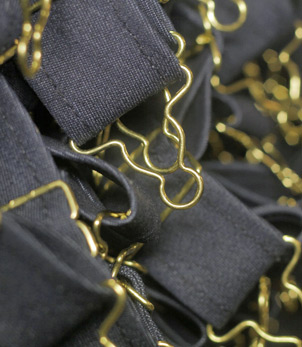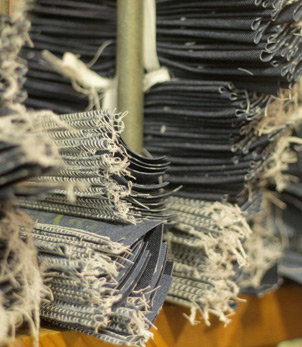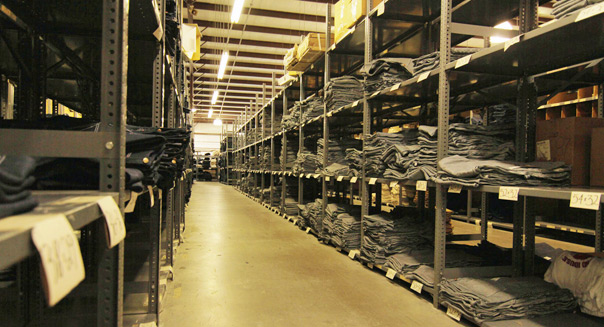Round House Denim: From Rail Crews to Global Fashionistas
It takes a certain kind of tenacity for a company to stand the test of time. A business begins. It is sold. Another owner takes the helm.
In our modern times, it’s highly unusual to find a company that can lay claim to both longevity and consistent quality. It’s even more unusual to find a company that has been producing goods since before much of the western U.S. territories became states.
Yet one such business still exists in Shawnee, Oklahoma — Round House American Made Jeans, which just celebrated 112 years of operation as the oldest manufacturer in the state. Its product hasn’t changed much since the company first started making work wear worn by railroad crews laboring to extend the train tracks westward. The same craftsmanship that took hold a century ago is still evident in the Round House jeans and overalls that carpenters and farmers across the country now don as their uniforms.
One step inside the company’s plant reveals a meticulous production process — fueled by decades of experience. But these days, Round House isn’t just producing for a local, or even a national market; you can also find their goods in Tokyo and other cities oceans away.

Chapter 1: Time-Tested Fabric
A whir of sewing machines welcomes visitors inside the Round House Denim factory in Shawnee, a city of 30,975 at the intersection of Oklahoma 18 and Interstate 40. The road you turn on to find Round House American Made Jeans is fittingly 1 American Way.
Road House was founded in 1903, when Oklahoma was an American Indian territory. Back then, an estimated 42 passenger trains and 65 freight trains rumbled through Shawnee daily, and the railroad workers who traveled with those trains in order to build passages West needed durable clothes. They found the attire they needed at Round House, a company so inspired by its customer base that its founders named the business for the building used to hold and fix locomotives.
Over the years, the company made its mark during many historical events. When other companies ceased production during the Great Depression, Round House continued to manufacture jeans, dungarees, aprons, jackets, shirts and overalls. In 1942, Round House began producing khakis for the U.S. Army.

The Antosh family has owned the company since 1964, when Edward Antosh bought the plant and became its president. Jim Antosh, Edward’s son, became manager in 1978 after graduating with a master’s degree in business administration and industrial engineering from Oklahoma State University.
In recent years the company has added on to its current location and seen record sales, something vice president David Antosh attributes to Americans seeking clothes made here in the U.S. “It started around the time of the [Great] Recession when people started buying close to home to help the economy,” he says.
But things weren’t always so easy for the Antosh family and Round House. When Jim took over, he was faced with one of the company’s biggest challenges to date — one of Round House’s biggest customers had fallen on hard times and subsequently pulled its product orders.
“When Dad took, over it was a low point because C.R. Anthony, a chain-store retailer, had stopped carrying Round House, and they were a major customer,” David says. “That was tough. The saving grace was that the company started selling to Walmart.”
That Walmart account of nearly 100 stores helped spur production during an all-time low. The visibility also helped attract new clients. Now the company ships to hundreds of Midwestern regional farm and home supply stores and chains.
Just last year Round House started selling online from the company’s website. Although online store accounts mark less than 5 percent of the sales, David believes it helps to improve relationships with customers. “Last year, we introduced four new jeans and five new jackets,” he says. “We can try new styles of jeans and jackets immediately and get feedback from customers right away. It’s nice to be getting feedback from customers. We are a growing company!”

Chapter 2: A Cut Above the Rest
A quote from Thomas Edison hangs in the hallway leading to the Round House factory floor. “Opportunity is missed by most people because it is dressed in overalls and looks like work.”
Next to the quote are old-time photographs from the company along with shots of Hollywood actors wearing the product in movie and television stills, including Jennifer Aniston, Hugh Grant and Jessica Simpson.

Upon entering the factory floor, the rhythmic display of the production process unfurls in front of you. Rolls of cotton fabric, sourced from the Texas Panhandle and weighing hundreds of pounds are stacked, ready for use. Material is laid 72 layers deep so someone can hand-cut them using an electric knife, slicing through all 72 layers at one time, directed by a pattern that employee Ginger Treme manages on a computer.
Treme organizes pattern pieces for Round Houses’ signature jeans and overalls over a simulated piece of material on her computer screen, careful to maximize the space available. Each overall alone has about 40 pattern pieces.
Unsurprisingly, in her free time, Treme solves jigsaw puzzles. She’s stuck with the company for 25 years. “I like what I do and I’m good at it,” she says.
At Round House, all employees takes pride and ownership over the task they’re responsible for. Velma Carr is charged with “felling,” the complicated task of sewing the front and back of the overalls and jeans together. Her fingers are wrapped in pink tape to protect them during the quick movement. Carr’s nearly 40 years with the company are evident as her pink-taped fingers orchestrate the machine’s fast mechanisms. The tape protects them as she brings two pieces of material together beneath the jackhammering needle.
Each day, Round House produces an estimated 1,250 jeans and overalls, which works out to about 25,000 a month and about 300,000 a year.
David estimates that 90 percent of the 75 employees are women and nearly a third have been here for two decades. In fact, the company takes the priorities of its female staffers — many of whom are mothers — into consideration when structuring the production schedule. The factory’s hours of 7 a.m. to 3:30 p.m. are in synch with school and day care hours. When snow closes these places down, many employees stay at home, worry-free, to care for their children and loved ones.
When the company is open, however, business is serious. Most eyes are focused on their fingertips and the new stitching being woven into the material. Employees rely on each other’s talents to keep orders moving smoothly. “No one can get too far ahead or too far behind, or someone runs out of work,” David says.
Quality and efficiency are key when your competitors spend little on employees. “We compete with companies in Bangladesh where they pay 10 cents an hour in labor costs,” David says.
How they remain on top lies with the employees, whose loyalty means little turnover, and whose experience has perfected the factory’s careful step-by-step process.
“We stay ahead [of competitors] by these things-having employees with a lot of experience who focus on quality and efficiency,” David says. “To compete against foreign-made companies with tremendously lower labor costs, our employees have to stay ultra-quick, efficient and error-free.”

Chapter 3: Going International
When the Antosh family bought the business in the 1960s, blue jeans were hitting the mainstream. Teenagers had started wearing them in youthful rebellion as part of a uniform that symbolized the individuality of the free-spirited 1960s. They were no longer just the staple of ranchers and cowboys — denim was suddenly cool.
In recent years, another sort of denim revolution has taken place in Round House’s business model. The onetime all-American style standard has become increasingly popular overseas.
From Shawnee to the international market, Round House now exports to more than 20 countries, including China. According to David, shipping overseas began to take off for the company in the early 1990s when Japanese firms reached out to Round House because of the country’s appreciation of American-made jeans.
Japan remains the company’s largest international customer base, with people in cosmopolitan areas like Tokyo wearing Round House jeans and overalls as fashion statements. “They’re just really interested in American culture and American goods,” David says.
For many years the company worked with designer Daiki Suzuki of popular Japanese retailer Nepenthes, and it now has a partnership with Tokyo-based Via Transports. “Working with influential, trusted companies and individuals who understand the Japanese market has been key,” David says. “Japan makes up about half of our exports.”
The company’s expansion into the European market began in the late 2000s when Round House partnered with WP Lavori — the worldwide licensee of such international brands such as Woolrich John Rich & Bros. — and gained more popularity in Italy and throughout Europe. “The biggest challenge is probably the cost of shipping from the U.S. to retailers in the eastern hemisphere,” David says. “It can get expensive, but as we’ve increased exports, we’ve been able to work with freight companies to lower the costs.”
Yet despite increased overseas popularity, Round House customer base is still very much close to home. “We still do about 85 percent of sales in the U.S.,” David says, wearing his daily uniform of Round House jeans and dress shirt. “We just appeal to the American workers in what they want.”
